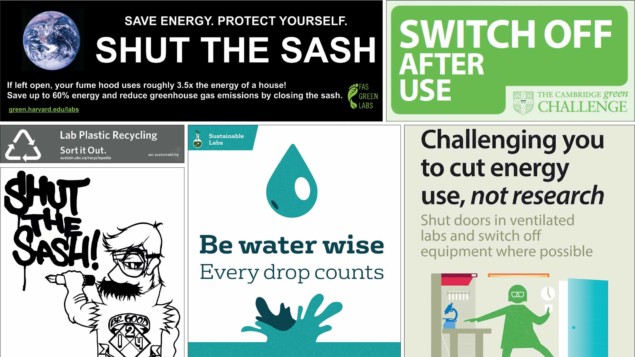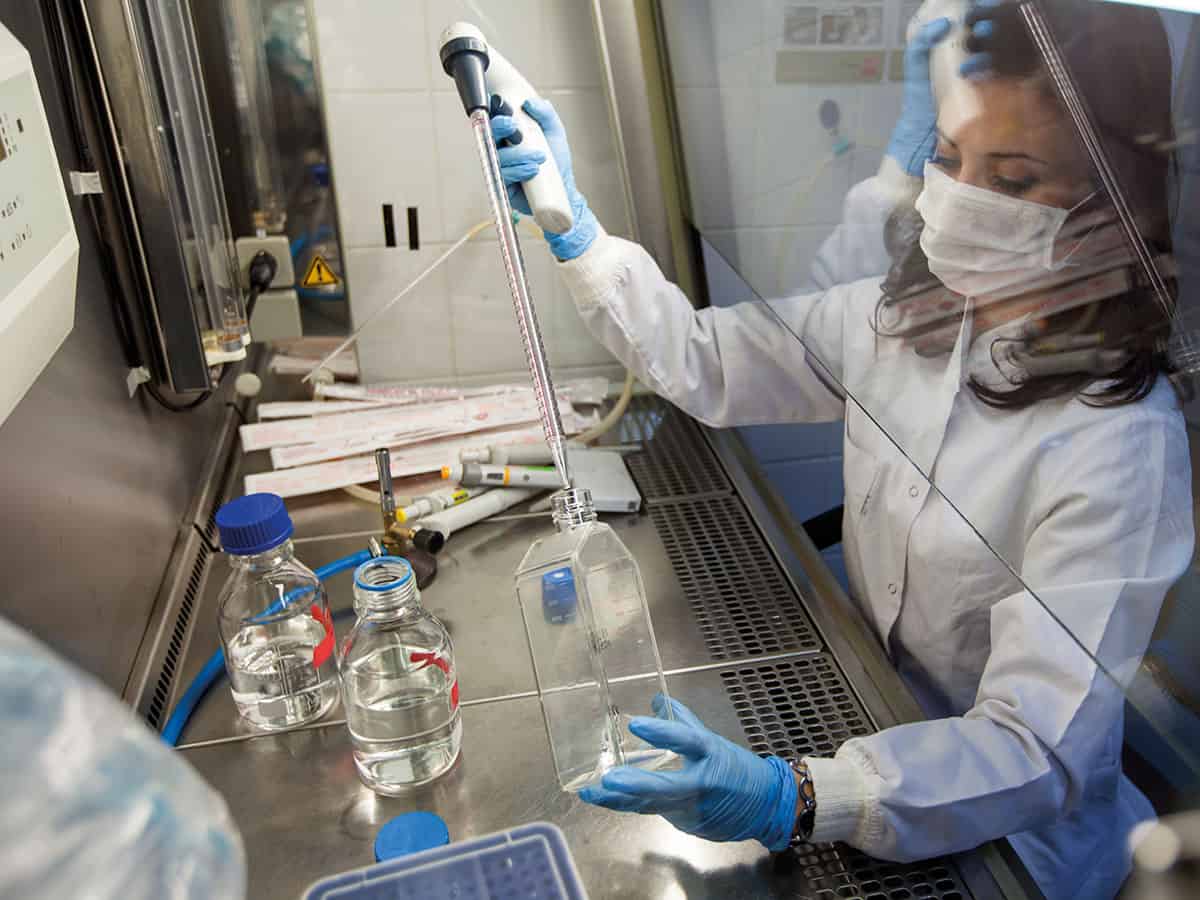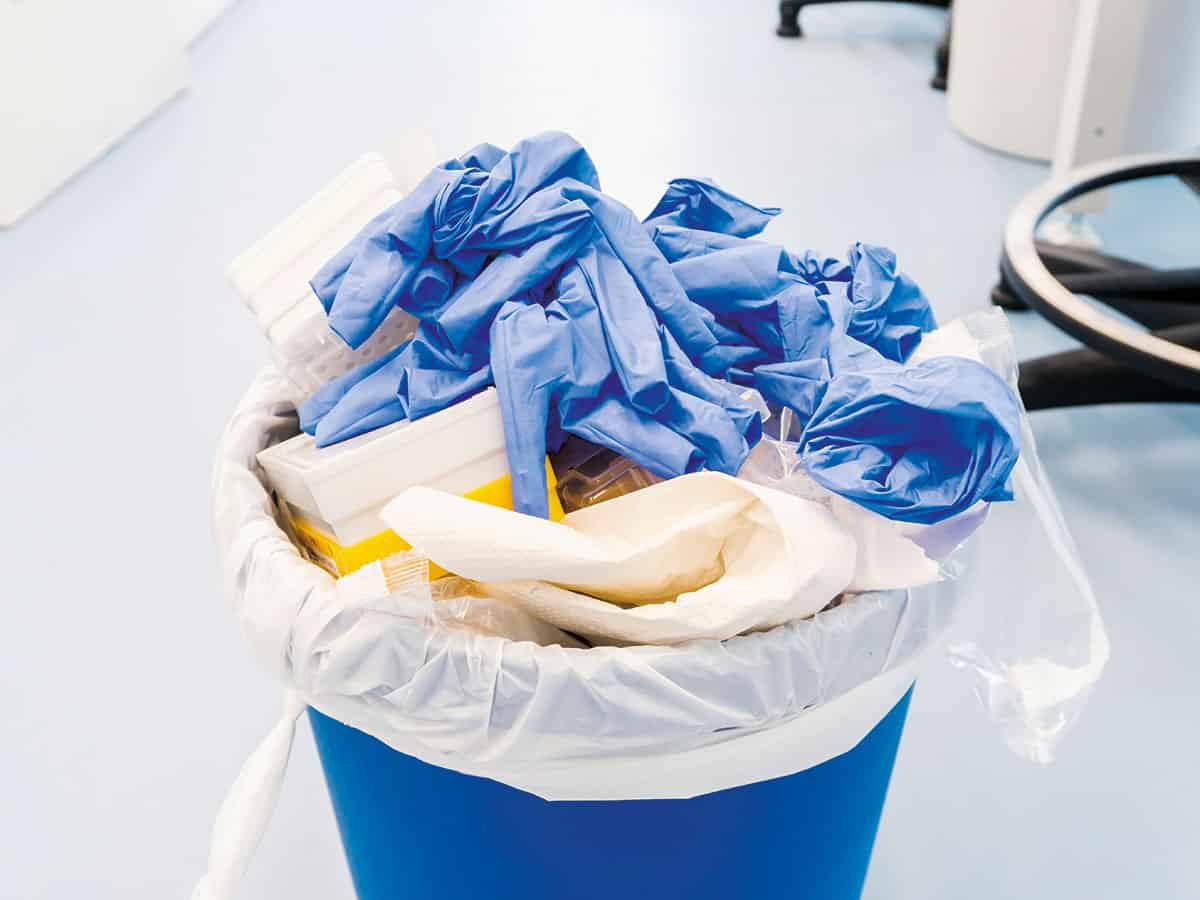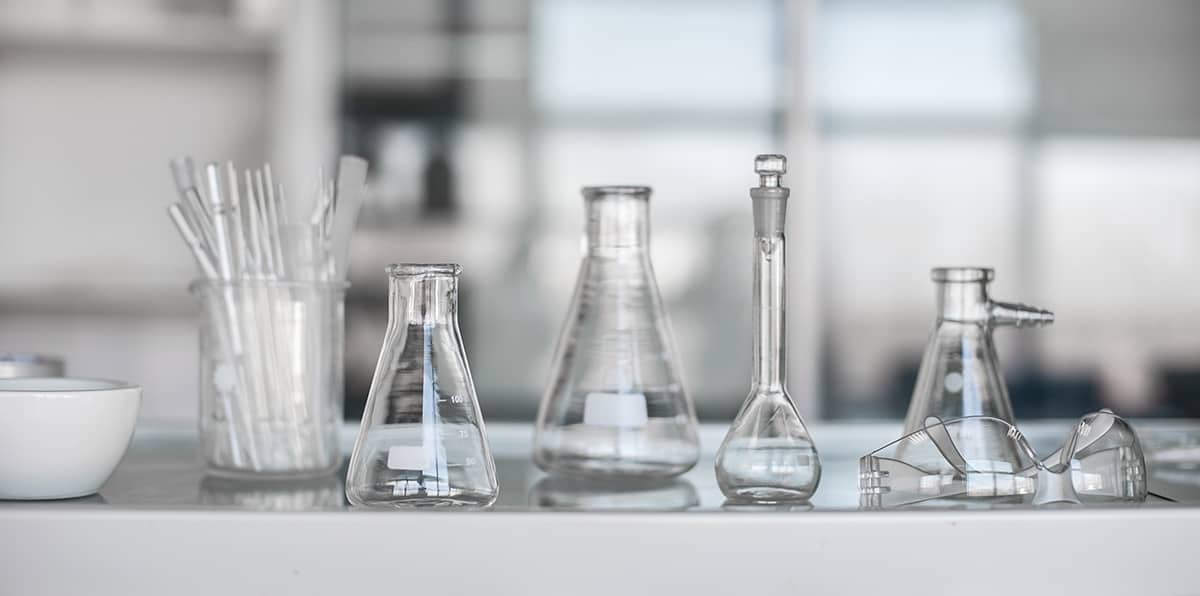With so much research focused on creating technologies that reduce our collective carbon footprint, the embarrassing realization that research labs themselves are some of the worst environmental offenders is only now starting to sink in. Benjamin Skuse examines the problem and what is being done to solve it

Walk into the clean, sterile environment of a typical laboratory, with equipment neatly arranged and work spaces clearly delineated, you would be forgiven for thinking it is the model of efficiency. But look closer and you might be surprised.
Take the fume hood, which is used to suck hazardous fumes away. If left open, as is common, it can consume as much energy as 3.5 homes over the same period. What about that line of ultralow-temperature freezers across the wall? Many of these are unnecessarily cold, often storing only a few or even expired samples, and each one uses as much energy every day as an average home over the same time.
“Research labs consume 10 times more energy and at least four times more water [per unit area] than office spaces,” says Allison Paradise, founder of the Californian non-profit organization, My Green Lab. “And they are estimated to throw away around 5.5 billion kilograms of plastic annually worldwide, which is enough to cover an area 23 times the size of Manhattan [59.1 km2] ankle-deep.”
At least part of this is a necessary evil. Many labs require air-conditioned environments running 24/7, and contain specialist equipment that is unavoidably energy- and water-hungry. And with experiments often producing hazardous or contaminated waste, single-use plastic remains key to maintain safety. Even theorists shouldn’t feel smug: supercomputers may be key to doing calculations and simulations that were previously impossible, but they consume a lot of energy and resources, with the world’s current fastest device – Summit in the US – requiring 17,000 litres of water a minute to keep it cool.
But this doesn’t mean nothing can be done. Paradise set up her lab-sustainability organization in 2013 after an epiphany about her time working in a biomedical research lab. “I was taught to leave equipment on all the time ‘just in case’,” she recalls. “I never once questioned this at the time, and it wasn’t until years later, after I’d already left the lab, that it occurred to me that leaving equipment on overnight can be wasteful and is largely an unnecessary use of resources.”
Having since dedicated her career to improving the sustainability of research, Paradise aims to change scientists’ attitudes towards energy, water and waste through My Green Lab. This means looking at every aspect of how research is conducted: from retiring old, inefficient freezers to considering different ways to commute to campus, such as carpooling.
My Green Lab offers three main solutions for science to be more green. One is a recognized standard for laboratory sustainability, to which more than 200 labs across North America have signed up. There’s an eco-label for laboratory products like a food nutrition label that provides clear, transparent information about environmental impact. Finally, it offers an energy star rating for one of the worst carbon offenders in the lab – those ultralow-temperature freezers.
Upgrading labs and attitudes
But the effort to support labs becoming more environmentally friendly is not just a North American endeavour. One of the most active institutions is the University of Bristol in the UK. In reaction to its students’ concerns about their future, Bristol recently declared a “climate emergency” and pledged to become carbon neutral by 2030. Key to achieving this goal will be the efforts of Bristol’s labs, which occupy only 6% of the university’s space yet account for 40% of the total energy, water and waste. They will be encouraged to upgrade buildings and use smart technologies to improve energy efficiency, such as automatically turning off lights when nobody is in a room. Researchers will also have to change how they behave when they are in the lab. “There is no point in having efficient lab equipment and waste-management processes if lab users aren’t on board,” says Anna Lewis, the university’s sustainable labs officer.

The most striking example of these efforts occurred last year, when the university’s entire Biomedical Sciences Building – consisting of 25 teams and more than 170 individual labs – gained a 100% Green Lab Accreditation, a UK-recognized badge of sustainability achievement. The award was earned through a range of actions, including replacing energy-inefficient laboratory kit, introducing a lab-equipment sharing system, and implementing lab plastic recycling and reuse schemes. All told, these efforts resulted in a £85,000 cut in the university’s energy bill over two years.
Bristol is now working with other UK universities to develop a successor to the Green Lab Accreditation called the Laboratory Efficiency Assessment Framework (LEAF). Much like the Green Lab Certification in North America, or the UK’s own S-Lab Awards – which has been honouring international labs for green laboratory design, management and operation since 2012 – the LEAF accreditation will be given based on various lab sustainability criteria, such as procurement, waste, equipment and ventilation. Crucially, however, the programme also produces metrics on savings – in terms of both carbon and cash – to allow baselines, targets and measures to be developed. With LEAF being piloted in 16 UK universities this year, Lewis says, “The government and the public expect greater transparency and responsible spending from universities – LEAF provides a tool and a means to do this.” While the School of Physics at Bristol had previously not applied for any green lab awards, it has signed up for LEAF.
Other global initiatives are also helping by “gamifying” lab sustainability. For example, in the Freezer Challenge, labs are awarded points for reducing their freezer energy demands, while Shut the Sash is a competition that started in 2005 to combat the high energy consumption of fume hoods.
Yet this burst of voluntary challenges, accreditations and incentives raises the question: why are many labs still averse to going green? Unsurprisingly, the answer is complicated, but boils down to ingrained preconceptions and a lack of motivation.

A common belief is that green lab practices can hamper research quality or even be bad for health and safety. “The truth is actually the opposite,” says Lewis. “For example, efficient ultralow-temperature freezers that are maintained correctly have longer lifespans and are less likely to break down, improving sample security and long-term equipment costs.” Paradise agrees. “In many cases the more environmentally sustainable approach is also the safer, more economical approach as well,” she says.
For Lewis, motivating researchers to focus on sustainability has been the hardest nut to crack. With their priority being high-quality research, many scientists simply don’t have the time to think about green practices. That is why the University of Bristol is offering students a chance to volunteer in research labs to help work through the sustainability criteria. “This benefits the students by allowing them access to research labs that they wouldn’t ordinarily have, as well as gain a knowledge of the underbelly and workings of the university,” says Lewis.
Big issues for big labs
At a different scale, making large scientific experiments and facilities – which necessarily consume vast amounts of resources and energy – more sustainable requires an even more holistic approach. The new £700m Francis Crick Institute – a huge biomedical research laboratory in central London – does this by incorporating sustainability principles into the entire design of the building. For instance, the institute uses an on-site combined heat and power system with 1700 m2 of solar panels installed on its south-facing roof. It also incorporates “plug-and-play” laboratories that ensure facilities can be shared and readily adapted to future needs, while a third of the floor area is given over to plant space. There are even roof gardens to attract wildlife.
“Our BREEAM Excellent rating was a great achievement for the design and build of the Crick,” says Rajnika Hirani, head of sustainability and business, referring to the Building Research Establishment Environmental Assessment Method – an internationally recognized certification of a building’s sustainability. “We are now going for the BREEAM In Use accreditation, which should really make a difference to the individual labs,” she adds, talking about another BREEAM rating that measures sustainable improvements through operational efficiency.
A long journey ahead
Over in Sweden all waste heat from the European Spallation Source, which is currently being built in Lund, will eventually be connected to the local heating system rather than being vented into the atmosphere. But for many big-physics labs, sustainability cannot be ingrained in the design. Take the CERN particle-physics lab near Geneva. Largely built years before sustainability was even a consideration, the thousands of huge, helium-cooled superconducting magnets and countless other components in the Large Hadron Collider (LHC) and other particle accelerators on site consume vast amounts of energy.
CERN uses around one third of the energy consumption of the canton of Geneva – equivalent to about 300,000 UK homes
Over the course of a year, the whole of CERN uses 1.3 TWh of electric energy when in operation. “We are around one third of the energy consumption of the canton of Geneva, or 0.2% of the total electrical consumption in France,” explains Frédérick Bordry, CERN’s director of accelerators and technology. This is equivalent to about 300,000 UK homes for a year. “In terms of accelerators, CERN is the biggest and therefore most energy-hungry facility in the world.” Even the magnets’ superconducting cables require as much energy to be cooled to their operating temperature (1.9 K) as they save in carrying current without resistance.
To improve CERN’s energy efficiency on a limited budget, Bordry has had to prioritize sustainability improvements. “Every time I have people come in they say, ‘Why are you not doing photovoltaics (PV) on the buildings?’” he says. “Our new buildings do have PV on the roofs and a lot of insulation, but if I have one or two million euros to spend, obviously it is better to inject it into the 90% of energy consumption [used by the machines, detectors and computing] rather than the 10% [the buildings use].”

One example of this spending in action is the ongoing renovation of the PS East Experiment Area, one of the oldest and largest structures at CERN, housing multiple beam lines. “We will install new special software, and new magnets and power converters that will run in pulsed mode instead of DC mode,” says Bordry. “These will save 90% of the energy.”
CERN has also introduced design criteria for new accelerators and equipment that focus on sustainability, including the 10-year cost instead of simply the purchase price. This means that when people are upgrading or buying new equipment, they see “the consequences of their spending to inform their consciences” in the form of a “virtual invoice”.
Of course, CERN is limited in what it can do to go green. For example, the four huge and expensive detectors installed in the LHC were intended to last for the life of the facility, but only one – CMS – took account of energy consumption in its design. CERN will have to wait until the LHC’s successor – whatever that may be – is installed in the 2040s and 2050s before it can claim its flagship accelerator has any meaningful green credentials.
Equally, upgrading or replacing the other energy-hungry CERN accelerators will take time, given that some are as old as the organization itself. But with energy efficiency and sustainability now hardwired into every new purchase and decision made at CERN, it too is showing that science, however energy intensive, is taking its responsibility seriously in leading efforts to reduce our collective carbon footprint.
Top five tips to go green in the lab
- Turn off equipment when not in use. “Use outlet timers for equipment that has heating/cooling elements so that the equipment reaches the correct temperature before you arrive in the lab,” advises Allison Paradise, founder of My Green Lab in the US.
- Use glassware whenever possible and take advantage of plastic and other recycling and take-back programmes. Gloves, Styrofoam coolers, water purification cartridges, packaging, pipette tips and many more items don’t have to go to landfill.
- Get your lab organized. Creating and maintaining a decent inventory system allows you to remove broken equipment and expired samples, avoid replicating purchases and frees up space, meaning some equipment can be switched off.
- Set up an equipment sharing, donating or renting system. “We ask lab users to share their space and equipment and check that they aren’t purchasing something that they could borrow or use from elsewhere in the university,” explains Anna Lewis, sustainable labs officer at the University of Bristol, UK.
- Exchange ideas. Joining schemes such as My Green Lab, S-Lab and LEAF allows you to see what other labs and institutions are doing to improve their sustainability. “There is so much going on that we are all happy to share to collectively reduce our impact on the environment,” says Rajnika Hirani, head of sustainability and business at the Francis Crick Institute in the UK.




